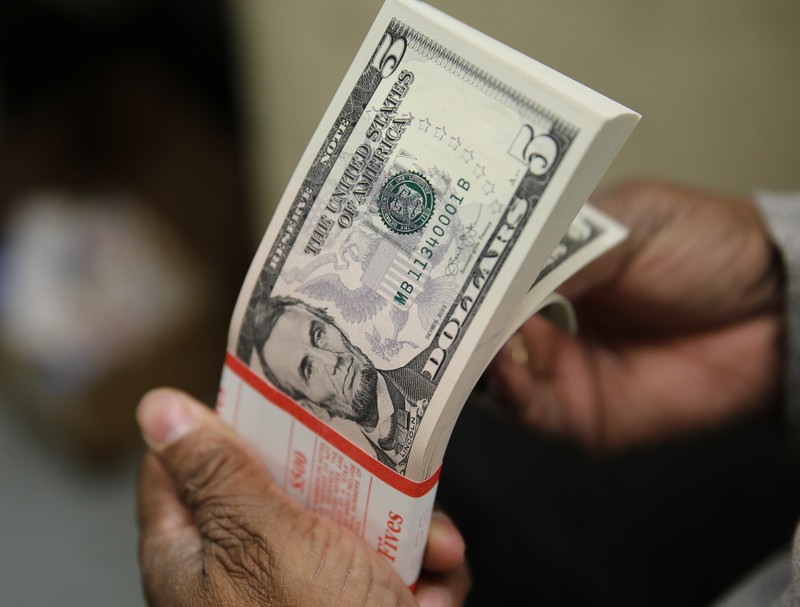
FILE PHOTO: A packet of former U.S. President Abraham Lincoln five-dollar bill currency is inspected at the Bureau of Engraving and Printing in Washington March 26, 2015. REUTERS/Gary Cameron/File Photo
April 11, 2019
By Hideyuki Sano
TOKYO (Reuters) – The dollar hovered near two-week lows on Thursday as Federal Reserve minutes reinforced its recent dovish policy tilt while the pound held steady after European leaders extended the deadline for Britain to leave the union.
Currency markets are also awaiting key economic data from the world’s second-largest economy with March Chinese trade figures due on Friday and first quarter gross domestic product due next week.
The U.S. dollar lacked momentum, with its index against six other currencies hovering near a two-week low, as the minutes from the Fed’s last meeting cemented its recent dovish policy stance with no change to rates expected this year.
The dollar index last stood at 96.93, flat on the day after having slipped to a two-week low of 96.823 on Wednesday.
U.S. central bankers also debated possible policy moves the Fed could make after it ends its balance sheet reduction program by September, with some advocating purchases of U.S. Treasury securities at that point.
“Some people say the minutes contained few surprises but a close look suggests the Fed is likely to become more dovish as time goes by,” said Daisuke Uno, chief strategist at Sumitomo Mitsui Bank.
The U.S. consumer price data released on Wednesday also painted a mixed picture, with annual core CPI inflation slipping to 2.0 percent in March, the smallest increase since February 2018.
The dollar changed hands at 111.07 yen, having fallen 0.58 percent so far this week.
The greenback also gave up its earlier gains against the euro that were driven on Wednesday when European Central Bank President Mario Draghi underscored growing risks facing the euro zone economy.
The ECB left its ultra-easy stance unchanged as expected and Draghi noted that economic data was weak.
He also confirmed the ECB was considering if measures were needed to mitigate the impact on banks of its negative deposit rates as well as the pricing of new cheap two-year loans to banks.
The euro last held at $1.1276, recovering from Wednesday’s low of $1.12295, keeping intact its slow uptrend from $1.1183 touched on April 2.
It is up 0.52 percent so far, which will be its first weekly gains in four weeks if sustained.
The British pound stood little changed at $1.3097, staying in a triangle holding pattern between $1.2945 and $1.3380 during the past month or so.
Sterling showed no reaction after the EU delayed the deadline for Brexit for the second time in less than a month, in line with market expectations that Britain will not crash out of the bloc on Friday without a deal.
Still, the decision did little to boost clarity on exactly how, when, or even if at all, the UK will leave the EU, is keeping the pound in check.
“At least there won’t be a no-deal Brexit this month. But while I’m no expert on British politics, it seems difficult for the parliament to come to any agreement,” said Kazushige Kaida, head of forex at State Street Bank.
“They just kicked the can down the road. Once the dust settles, I would expect to see selling in sterling,” he added.
The implied volatilities on the pound’s options plunged, with three-month volatilities falling to 8.325/8.825 percent, a level last seen in late August.
It has slipped below the actual volatilities over the past three months, which stood at 9.17 percent on Thursday.
The Australian dollar dipped 0.15 percent to $0.7157, having hit a six-week high of $0.7175 on Wednesday after the country’s central banker signaled the outlook for interest rates was still uncertain and stopped well short of adopting an outright easing bias as some had wagered on.
It barely moved after China’s factory-gate inflation picked up for the first time in nine months in March, edging away from deflationary territory, in a fresh sign of a boost to economic activity from stimulus.
Commodity currencies including the Aussie were also helped by recent firmness in commodity prices.
The South African rand traded at 13.9175 to the dollar, having touched a six-week high of 13.8975 the previous day.
(Editing by Sam Holmes & Shri Navaratnam)

